After a year of damaging headlines, this Aussie town has bounced back
By Andrew Bain
In a storeroom deep inside the Araluen Arts Centre at Alice Springs’ edge, gallery senior director Felicity Green rolls out a wire rack holding an Albert Namatjira painting. It’s an open scene of the country on which Araluen now sits. The desert grasses are fresh and green after rain, and the only visible human structure is a house set among the trees, with Heavitree Gap splitting open the mountains behind.
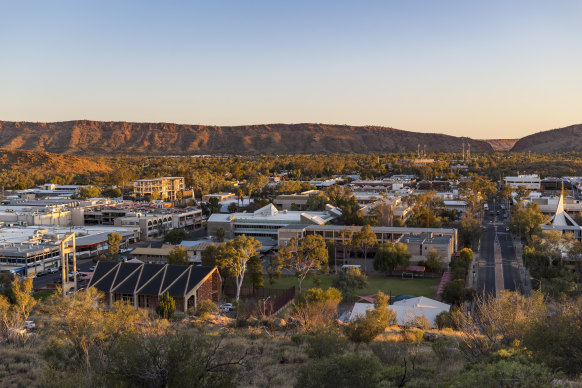
Alice Springs remains a big country town with big country ways.Credit: iStock
“That’s the house in which I live,” Green says.
Outside of this backroom, one of Alice Springs’ largest cultural events, Desert Mob, has taken over Araluen’s galleries, filling its walls with work from 35 surrounding Aboriginal art centres and demoting the permanent collection to storerooms and racks. But it’s taken only a question to find myself backstage in a private audience with more than a dozen of the gallery’s 70 Namatjira artworks.
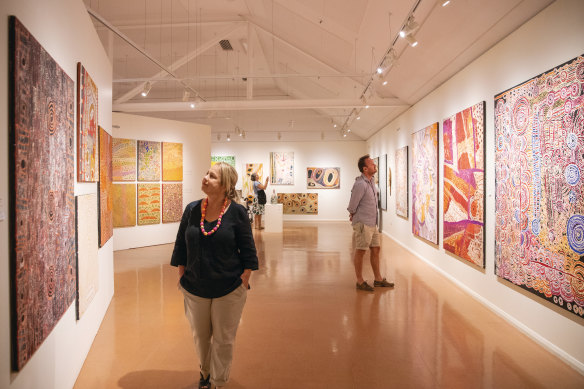
Desert Mob - a contemporary collection from Indigenous artists.Credit: Tourism NT/Araluen Arts Centre
Though suffering under the weight of negative publicity that accompanied a surge in violent crime in 2022, Alice Springs remains a big country town with big country ways – a place where even a major gallery will readily throw open closed doors on Australia’s second-largest collection of one of its most celebrated artists.
Chat to locals and they unsurprisingly scoff at the headlines from outside media, while police have reported that crime in Alice has dropped again to its lowest level since 2019. Visit and the town feels anything but a frontline, with art and nature back at the fore.
Days open, as almost everywhere, with coffee, but in Alice it can have another dimension. Inside the arid Olive Pink Botanic Garden, breakfast at the Bean Tree Cafe comes with a likely side serve of sightings of black-flanked rock wallabies. Tables are lined along the base of boulder-covered Tharrarletneme (Annie Meyers Hill), which in the cool of morning is a favourite haunt of these agile, near-threatened wallabies. Scan the slopes over your smashed avo and there’s likely to be macropod movement.
Failing any sightings from the tables, a short walking trail climbs through the boulders to the top of the hill – a walk in the company of wallabies, with an expansive outlook over Alice Springs and the MacDonnell Ranges as a summit bonus. It’s a glorious view, and yet it’s only Alice’s second most popular sunrise hangout, with Anzac Hill, at the town centre’s edge, drawing most of the dawn love.
As the days break open and Alice rises for business, time can easily become dominated by art. Alice is said to have Australia’s highest number of art galleries per capita, and the scene is unsurprisingly dominated by Indigenous art. Prime among the dozens of galleries are Tjanpi Desert Weavers and Iltja Ntjarra Many Hands Art Centre, which sit almost side by side in the unlikely setting of an industrial area across the highway from the town centre.
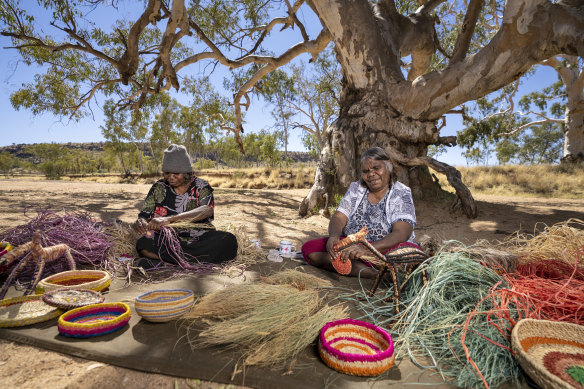
Tjanpi Desert Weavers at work.Credit: Tourism NT
In this spot where you more expect to find a garage than a gallery, the Indigenous owned and directed Iltja Ntjarra Many Hands has for 20 years been upholding the Hermannsburg School style of art, created and popularised by Albert Namatjira. Watercolours are the non-profit gallery’s predominant medium, though it also plays with the traditions, producing artworks on items such as drinking cans and repurposed road signs.
About 20 artists work with the gallery, many of them descendants of Namatjira, and visitors are welcome to wander among the artists as they paint – up to eight artists at a time can be working in the studio, typically from around 10am to 3pm Monday to Thursday. A gallery out the back of the studio provides a further display of up to two dozen works by Iltja Ntjarra Many Hands artists.
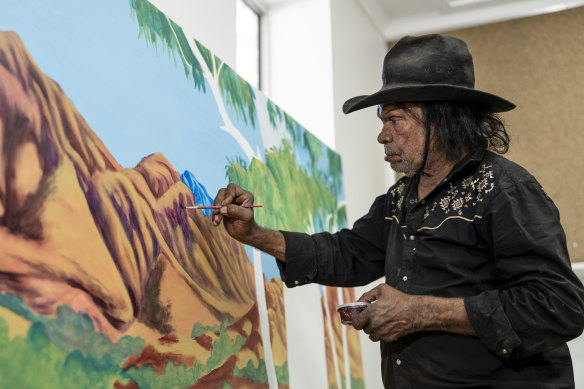
Iltja Ntjarra (Many Hands) – upholding the Hermannsburg School style for two decades.Credit: Tourism NT
On the same street, Tjanpi Desert Weavers began in 1995 as a series of basket-making workshops. Tjanpi means “grass” in Pitjantjatjara language, and artists from the social enterprise collect the tjanpi by hand, heading out onto Country to harvest native desert grasses, which they then weave (along with materials such as raffia, wool, string and emu feathers) into whimsical, wiry figures – from ever-popular dogs and echidnas through to lizards, donkeys and an occasional Royal Flying Doctor Service plane – that fill the shelves of two showrooms inside the Alice studio.
Twice a year Alice goes into art overdrive with a pair of long-running festivals at the Araluen Arts Centre, which this year celebrates its 40th anniversary. Each June, the town warms its head with the four-day Beanie Festival, typically featuring up to 500 beanie makers producing thousands of varied headpieces. Desert Mob fills three of Araluen’s four galleries with artworks from Central Australian community art centres for six weeks from September.
As Central Australian days inevitably heat up, thoughts turn to cooling down. The dry bed of the Todd River begins to feel like mockery from nature, but you need only cross through Heavitree Gap – the break in the mountains that separates the West MacDonnell Ranges from the East MacDonnells – to find an antidote.
Tucked behind a row of date palms is the beer garden for Alice Springs Brewing Co. The town’s only brewery, established in 2018, it produces easy-drinking lagers and ales geared towards the scorching Red Centre climate, with a surprising stout thrown in. Tours of the brewery operation run weekly, and the large and busy bar has six of its beers on tap and a pizza menu that reads like a stand-up routine – try the Ba Ba Greek Sheep or the Much Prefer a Margarita (“The drink is better, but everyone must eat”).
Alice’s other cooling options are typically found etched into the mountains outside of town.
The Tjoritja/West MacDonnell Ranges, which stretch for 150 kilometres west from Alice, are split by multiple gorges, elegantly dividing the mountains into slices. Many of these ancient gorges are filled with water, creating a string of cool oases as you drive across the desert.
The best of the swimholes is found near the range’s end, in deeply etched Ormiston Gorge, where the mouth of the winding gorge is permanently pooled with water up to 14 metres deep. When I arrive, the midday sun burns down on a beach scene 900 kilometres from the nearest ocean beach. The sandy riverbed is a mosaic of towels and bodies, but it’s the water that’s most inviting, set beneath cliffs that tower from its surface and keep rising into red, spinifex-dotted mountains covered in the brilliant white brushstrokes of ghost gums.
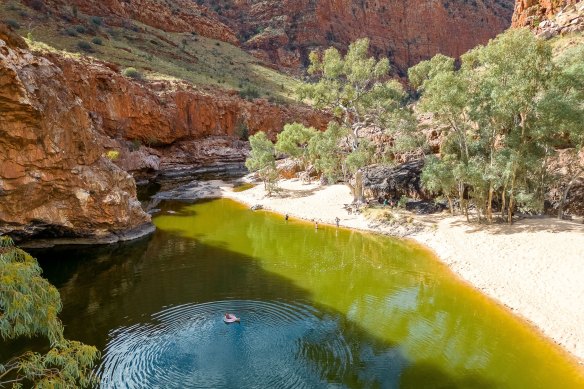
A beach a long, long way from the ocean - Ormiston Gorge.Credit: Tourism NT
Beyond the waterhole, the gorge beckons walkers as it wriggles through the mountains and out into the encirclement of Ormiston Pound. One of the Northern Territory’s best day walks, it completes an 8.5-kilometre loop back at the waterhole and provides a welcome excuse for another lingering swim.
The drive back to Alice from Ormiston Gorge is a chance to sample the West MacDonnells’ collection of other gaps and gorges. If the water at Ormiston Gorge wasn’t cold enough, the cliff-lined pool at the even deeper Ellery Creek Big Hole certainly will be, and while Standley Chasm has no water, it’s arguably the most spectacular stop along the range.
Arrernte owned and operated Standley Chasm is reached along a short walking trail that tunnels into the range, so that it already feels as though I’m deep within the mountains by the time I reach the chasm’s narrow entrance.
The natural alignment of the deep fissure fills it with sunlight and visitors each day for about 90 minutes around midday. By arriving late in the afternoon, however, I have the site to myself – a brighter prospect even than the brilliance of its glowing orange walls in the full glare of its midday spectacular.
Stepping inside the corridor-like chasm, the smooth quartzite walls rise 80 metres overhead and it’s as though I’ve been swallowed by the mountain range. Behind me, river red gums form a lattice-like screen across the entrance. Ahead, a rocky bluff protrudes from the cliffs, seemingly guarding the sacred space beyond, which is closed off to visitors.
Among the hard rock, with my view confined to this skinny red slot, nothing moves. The world is as still as a painting, and as colourful as an abstract. It’s Alice Springs nature suitably appearing like art.
FIVE PLACES TO EAT IN ALICE SPRINGS
Hanuman
The doyen of Alice dining, with a shuffled pack of Asian dishes – Goanese prawns alongside Thai chilli prawns and wild barramundi fillets – inside the DoubleTree by Hilton Hotel.
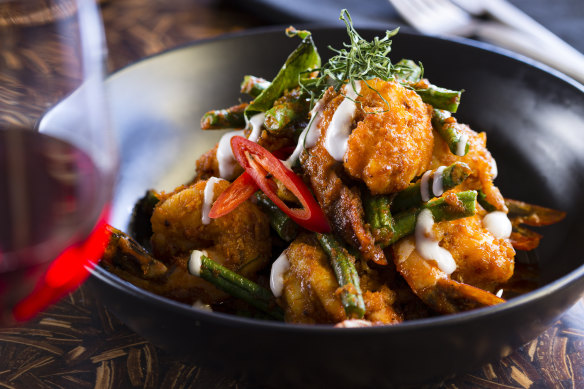
A dish at Hanuman.
DuYu
This long-time local coffee roaster morphed into Alice’s coolest cafe in mid-2022. Find it inside an old warehouse behind a rusted shipping container, with tables set around a baby grand piano and aquarium.
Page 27
Alice Springs’ take on a Melbourne laneway experience, blending funky design with a wide-ranging breakfast menu inside one of the mall’s shaded arcades.
Epilogue Lounge
Page 27’s sister eatery, across the mall, with so much more – as the day ticks over, breakfast becomes tapas, cocktails and a night-time rooftop bar with live music.
Yaye’s Cafe
Adjoining the Araluen Arts Centre at the town’s edge, Yaye’s will happily make you those eggs on toast, but there’s always the South American option of the signature empanadas and the Inca salad.
THE DETAILS
VISIT
Qantas flies daily to Alice Springs from Sydney, and four times a week from Melbourne. Alice Springs Expeditions organises bespoke tours in and around Alice. See qantas.com, alicespringsexpeditions.com.au
STAY
Camp in style in one of three glamping tents at Squeakywindmill, or drive 30 minutes south of town for an evocative station stay at Ooraminna Station Homestead. A film location for The Lost Flowers of Alice Hart mini-series, the homestead has four outback-chic cottages dotted through the scrub as well as glamping tents and a new desert infinity pool. See squeakywindmill.com, ooraminna.com.au
The writer travelled courtesy of Tourism NT, see northernterritory.com.
Sign up for the Traveller Deals newsletter
Get exclusive travel deals delivered straight to your inbox. Sign up now.